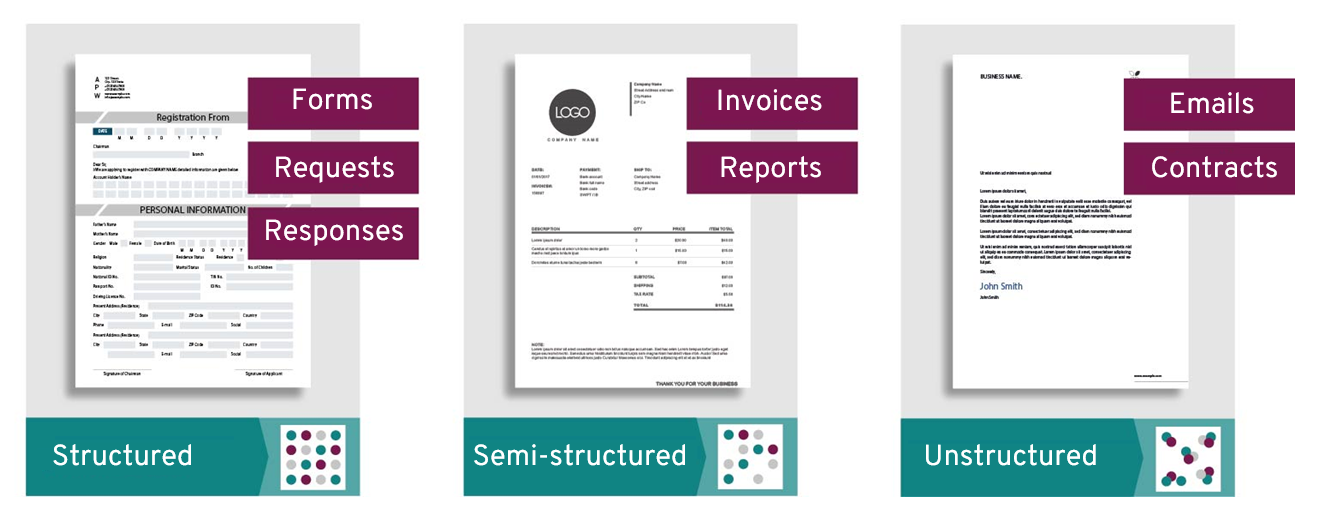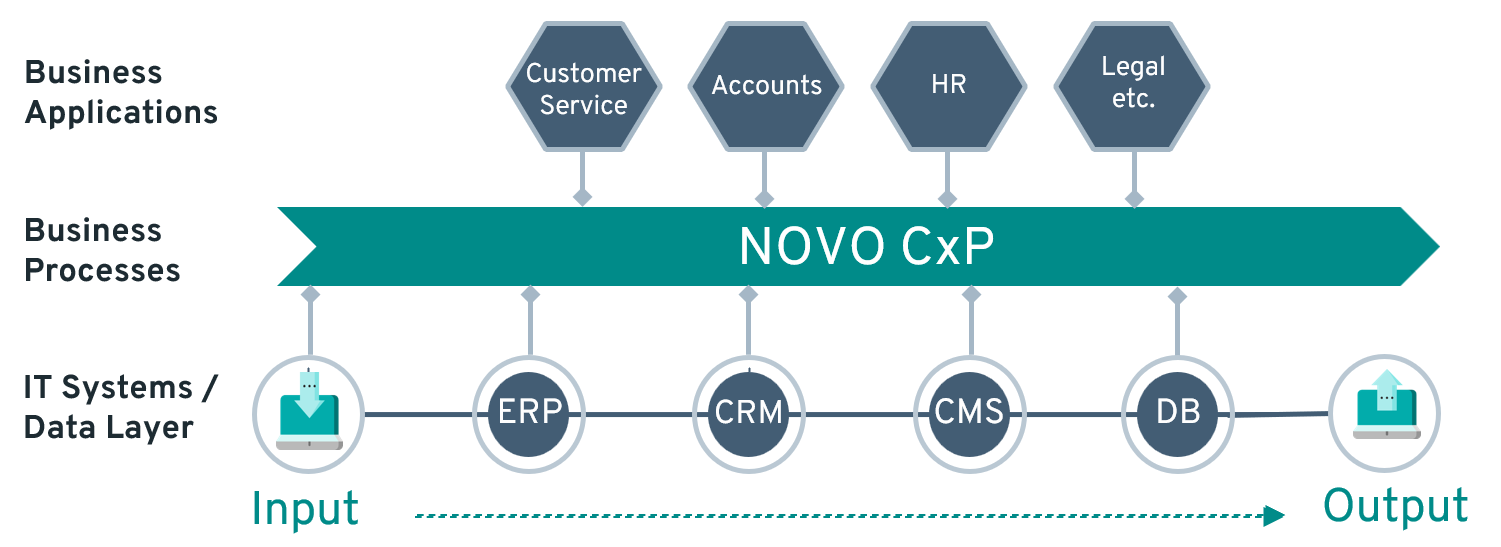What is Data Extraction?
Data extraction refers to the process of systematically retrieving relevant information from structured, semi-structured, or unstructured data sources. These sources can be documents, emails, PDFs, databases, forms, or also scanned receipts. The goal of data extraction is to make the information contained in these sources machine-readable so that it can be processed automatically — for example, in automated workflows.
Data extraction is an essential part of automating business processes, as it enables automated invoice processing, email processing, customer service automation, and more.
Go to:
- What is Data Extraction?
- Why is Data Extraction so important?
- In which areas is data extraction used?
- What types of data can be extracted?
- Data extraction technologies and methods
- Benefits of intelligent data extraction
- How does data extraction enable automated processes?
- Choosing the right software: Solutions by inovoo
- Intelligent data extraction is the key to optimized processes
Why is Data Extraction so important?
Today, many business processes must run digitally in order to handle the enormous amounts of data and satisfy customers. As a result, companies are confronted with a large amount of information from a wide variety of channels every day: paper documents, emails, online forms, chat histories, scans, and PDFs. Although the information is usually already available in digital form (paper documents are scanned, for example), it is still unstructured—meaning that it cannot be used directly by automated systems. Employees have to manually check and interpret the content and transfer it to systems – a time-consuming and error-prone process. This is where automated data extraction comes into play. It enables information to be made accessible quickly, efficiently, and with virtually no errors, so that it then can be processed automatically in the rest of the process.

Which areas use data extraction?
Data extraction is used in a wide variety of industries and use cases. Wherever a company has incoming data that needs to be processed automatically, data extraction gets the process up and running:
- Incoming mail processing: Automatic extraction of data (e.g., customer data, details of requests, etc.) from letters, emails, attachments, and forms.
- Inbound invoice processing: Not all invoices are received in structured formats (e-invoices). In PDF invoices, for example, amounts, IBANs, and invoice numbers must be read so that the verification and approval process can run efficiently.
- Customer Service: Structuring service requests for intelligent distribution to the responsible teams or systems.
- Insurance processes: Customers send claims data in unstructured attachments (forms, descriptions, images, etc.). These also need to be retrieved and structured.
- E-Government and Administration: Applications, citizen forms, and special mailboxes —all of these communications contain important data that needs to be extracted.
What types of data can be extracted?
Data extraction can be applied to many different types of information:
| Data type | Examples |
| Structured data | Databases, tables |
| Semi-structured data | XML, JSON or CSV files, emails with fields |
| Unstructured data | PDFs, scans, letters, free text fields, contracts |

Extraction from unstructured sources is particularly challenging, as there are no clear layouts or predefined fields.
Data extraction technologies and methods
Data extraction has evolved significantly in recent years. Traditional methods have been complemented by modern, AI-supported approaches:
OCR (Optical Character Recognition)
Optical character recognition is used to convert scanned documents into machine-readable text. OCR is the basis of many extraction processes.
Rule-based extraction
Use of predefined rules (e.g., “If IBAN, then 22-digit number sequence”). Effective, but not adaptive.
Template-based extraction
This technology can be used to extract data from highly standardized documents (e.g., forms, invoices with a uniform layout, etc.).
As soon as the structure of the documents changes, the system must be adapted. Also, additional unstructured data (e.g., handwritten comments outside the form fields) is usually not recognized.
AI-based extraction
With new AI technologies, especially large language models (LLMs), even unstructured data can be extracted without preparation. This means that, for example, the structure of a form and any possible changes no longer matter—the relevant information is still recognized with a high degree of accuracy. The decisive factor here is the ability of LLMs to work in a context-based manner, i.e., to understand documents in a similar way to humans and to independently recognize which data can be found in which parts of the document.

Benefits of intelligent data extraction
The use of intelligent data extraction—especially based on AI technologies—offers companies multiple measurable benefits. Compared to manual extraction, intelligent data extraction enables significantly higher efficiency, accuracy, and scalability:
- Time savings: Automated extraction significantly reduces processing times. Information from emails, forms, or PDFs is available for further processing almost in real time. This means that requests can be processed more quickly and deadlines can be met.
- Cost efficiency: Employees can use their valuable working time for more complex tasks. In addition, error rates are reduced, which means that reworking or corrections can be avoided.
- High accuracy and quality: Intelligent data extraction means low error rates. For unstructured documents, this can be achieved with the help of AI technologies.
- Scalability: Modern platforms can be flexibly adapted to new processes and increasing document volumes.
- Improved transparency and control: Dashboards and monitoring tools (such as NOVO BI Board) allow you to monitor, evaluate, and optimize the extraction process in real time.
How does data extraction enable automated processes?
After automated data extraction, the data is not only available in digital form, but also in a structured format. What happens next? The biggest advantage of structured data is that it can be transferred to an automated workflow. Now the data can be...
- classified (e.g., by request, department),
- forwarded to the specialist systems,
- processed (e.g., filing, document entry, etc.),
- and transferred to the target systems.
With modern low-code platforms, such workflows can be easily configured using drag-and-drop, without the need for further IT knowledge.
Choosing the right software: Solutions by inovoo
To make the most of the advantages of intelligent data extraction, you need a platform that feeds structured data into an automated processing workflow. NOVO CxP (Communication Exchange Platform) by inovoo is a modern solution that offers exactly that. It transforms unstructured data into well-structured digital information that can be used directly for further automated processing.
- Emails, scanned documents, forms, and various other data sources automatically trigger intelligent workflows.
- The platform processes content regardless of format, language, structure, or complexity.
- All processing steps are fully automated—from receiving the data to transferring it to your target systems.
Additionally, NOVO CxP creates a streamlined system landscape that fully leverages the potential of intelligent data extraction. Business applications and IT systems such as ERP, CRM, CMS, or databases are no longer isolated, but are directly and seamlessly connected through the integration with NOVO CxP:

Process automation with NOVO CxP: intelligent, connected, transparent
For particularly complex and diversely structured documents, we recommend the intelligent AI solution NOVO AI Studio based on LLM technology. This allows you to bring the power of LLMs directly into your processes and extract all the data from any document, no matter how unstructured, without prior training.
Intelligent data extraction is the key to optimized processes
Intelligent data extraction is a crucial component of any process that involves processing unstructured data. Companies that not only have information available in digital form, but can also analyze and process it automatically, save costs, accelerate processes, and improve service quality. With modern solutions such as NOVO AI Studio and NOVO CxP, inovoo offers the ability to implement data extraction intelligently —whether in customer service, administration, or the input management of large organizations.
